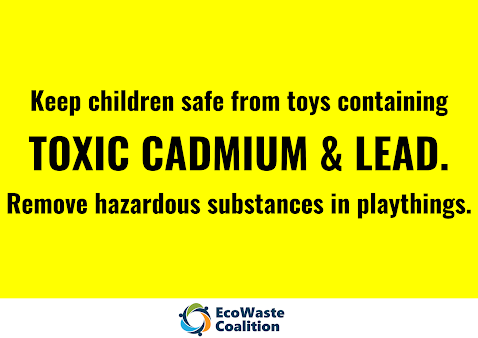Warning Out on Holen and Sipa Containing Toxic Cadmium and Lead
With the impending onset of the warm and dry season, the toxics watchdog group EcoWaste Coalition drew attention to hazardous substances in outdoor toys that are quite popular, especially among boys, during the hot months.
As part of its continuing drive to protect vulnerable children from toxic harm, the EcoWaste Coalition purchased samples of traditional Filipino toys used in the neighborhood “Larong Pinoy.”
Last Sunday, March 19, the group bought turumpo (wooden spinning toys), sipa (kick toys with shredded plastic skirt and lead washer base) and holen made of glass or marble from toy dealers at Divisoria Mall in Binondo, Manila.
The group then screened the samples for toxic metals such as cadmium and lead using a handheld X-Ray Fluorescence (XRF) analyzer.
“We’re happy to find the eight brightly painted turumpo compliant with our country’s lead paint regulation, which bans the use of lead-containing paints in children’s toys,” said Aileen Lucero, National Coordinator.
“This is good news for our children, especially if we look at past screening results,” she added. In sampling conducted by the group in 2014 and 2017, 94 percent and 73 percent, respectively, of the analyzed turumpo had lead above the regulatory limit of 90 parts per million (ppm).
Sadly, all the turumpo had zero labeling information in violation of Republic Act 10620, or the Toy and Game Safety Labeling Act of 2013, which also requires functional toys with accessible sharp points like turumpo to carry a cautionary statement on the packaging warning a “sharp point exists.”
“While lead was not detected on the plastic skirts of the 20 sipa samples, the lead washers had, unsurprisingly, over 10 percent or 100,000 ppm of lead,” said Lucero, “which will make them illegal to sell in the US.”
In the US, children's products manufactured in or imported into the country must not contain more than 100 ppm of total lead content in accessible parts and components.
As for the analyzed holen, the group detected cadmium and/or lead in all the samples. The highest levels detected were 447 ppm for cadmium on a blue marble and 568 ppm for lead on a black marble.
“Like the sampled turumpo and sipa, none of the holen was properly labeled as required by RA 10620, which will make them ‘misbranded or banned hazardous substance’ as per the law,” Lucero said.
According to RA 10620, “balloon, ball, marble, or toy or game which packaging is not in compliance with the requirements of this Act shall be considered a misbranded or banned hazardous substance (and) shall be withdrawn from the market at the expense of the manufacturer or importer.”
In addition to the standard labeling information, marble toys need to contain the following prescribed cautionary statement: “This toy is a small marble which may present a choking hazard. Not for children under 3 years.”
Cadmium and lead are on the World Health Organization’s list of “10 chemicals of major public health concern,” as well as on the Philippine Priority Chemicals List.
According to the WHO, lead “is a cumulative toxicant that affects multiple body systems, including the neurologic, hematologic, gastrointestinal, cardiovascular, and renal systems,” while “cadmium exerts toxic effects on the kidney, the skeletal system and the respiratory system and is classified as a human carcinogen.”
Among other public health recommendations, WHO is “promoting the elimination of the use of cadmium in products such as toys, jewelry and plastics.” It has also identified “primary prevention (as) the single most effective intervention against lead poisoning,” including the “elimination of the use of lead in homes, schools, school materials and children’s toys.”
The EcoWaste Coalition, which has been campaigning for safe and toxics-free toys for over a decade now, renewed its call on toy makers, toy regulators and toy sellers to ensure that only compliant child-friendly, non-hazardous and properly labeled toys are offered for sale in the market.
-end-
Reference:
https://www.officialgazette.
https://www.who.int/teams/
https://www.who.int/teams/






Comments